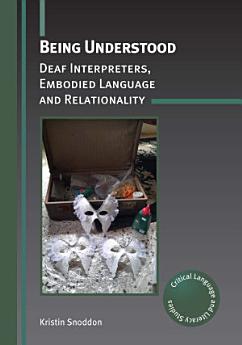Being Understood: Deaf Interpreters, Embodied Language and Relationality
Kristin Snoddon
ספט׳ 2025 · Critical Language and Literacy Studies ספר 34 · Channel View Publications
ספר דיגיטלי
172
דפים
family_home
כשיר
info
reportהביקורות והדירוגים לא מאומתים מידע נוסף
מידע על הספר הדיגיטלי הזה
Experiences of not understanding and not being understood during interactions are a pervasive aspect of life for many deaf people, so ensuring understanding becomes a moral imperative in deaf worlds and part of deaf ontologies. Through a series of linked applied linguistics studies regarding the primacy of text, signing songs, the mediation practices of deaf interpreters and Caribbean deaf epistemologies of language and understanding, this book outlines theoretical and methodological approaches to analyzing deaf people’s experiences of understanding and being understood. These are grounded in a Continental philosophy of language and qualitative methods including autoethnography, interpretative interviews and phenomenology. The book explores issues surrounding linguistic and semiotic repertoires; access and affordances; orientation, sociality and power; and mediated communication. Ultimately, it reveals both the workings of epistemic injustice related to deaf signers and ways of understanding and being understood that extend beyond named languages.
על המחבר
Kristin Snoddon is a Professor in the School of Early Childhood Studies, Toronto Metropolitan University, Canada. She is co-editor of Critical Perspectives on Plurilingualism in Deaf Education (with Joanne C. Weber, Multilingual Matters, 2021) and Sign Language Ideologies in Practice (with Annelies Kusters, Mara Green and Erin Moriarty, Mouton De Gruyter, 2020).
רוצה לדרג את הספר הדיגיטלי הזה?
נשמח לשמוע מה דעתך.
איך קוראים את הספר
סמארטפונים וטאבלטים
כל מה שצריך לעשות הוא להתקין את האפליקציה של Google Play Books ל-Android או ל-iPad/iPhone. היא מסתנכרנת באופן אוטומטי עם החשבון שלך ומאפשרת לך לקרוא מכל מקום, גם ללא חיבור לאינטרנט.
מחשבים ניידים ושולחניים
ניתן להאזין לספרי אודיו שנרכשו ב-Google Play באמצעות דפדפן האינטרנט של המחשב.
eReaders ומכשירים אחרים
כדי לקרוא במכשירים עם תצוגת דיו אלקטרוני (e-ink) כמו הקוראים האלקטרוניים של Kobo, צריך להוריד קובץ ולהעביר אותו למכשיר. יש לפעול לפי ההוראות המפורטות במרכז העזרה כדי להעביר את הקבצים לקוראים אלקטרוניים נתמכים.









